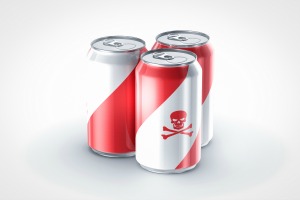By now, most of us know that soda isn’t exactly a health food and should only be consumed in moderation (if at all).
Studies have shown links between the sugary chemical cocktail and obesity, type II diabetes, metabolic syndrome, dental health problems, and cardiovascular disease.
The results of a new study about soda consumption were published in the online scientific journal PLOS ONE [2] yesterday, and the information [3] is disturbing.
Public health researchers analyzed soda consumption data to determine the level of exposure to 4-methylimidazole (4-MeI), a potentially carcinogenic (cancer-causing) byproduct of some types of caramel color. Caramel color is a commonly used ingredient in colas and other dark soft drinks.
The researchers found [4] that every day, more than half of Americans between the ages of 6 and 64 typically drink soda in amounts that could expose them to enough 4-MeI to increase their cancer risk.
From Consumer Reports [4]:
Among the more than half of Americans age 6 to 64 who drink soda on a typical day, it turns out that the average intake ranges from a little more than one 12-ounce can to nearly 2.5 cans a day. About a third of very young children (age 3 to 5) drink soda on a typical day; the average intake is approximately two-thirds of a can. The biggest soda consumers are in the 16 to 44 year-old age group. Those who drink the most average about three cans a day. “The findings of this comprehensive study have scientific, policy, and legal implications for calculating cancer risk and establishing limits for 4-MeI in food,” says Urvashi Rangan, Ph.D., toxicologist and executive director of Consumer Reports’ Food Safety & Sustainability Center.
Our analysis shows that at this level of consumption, we would expect to see between 76 and 5,000 cases of cancer in the U.S. over the next 70 years from 4-MeI exposure alone. “We don’t think any food additive, particularly one that’s only purpose is to color food brown, should elevate people’s cancer risk,” says Rangan. “Ideally, 4-MeI should not be added to food.”
Just how significant [4] is the risk?
Our analysis shows that at this level of consumption, we would expect to see between 76 and 5,000 cases of cancer in the U.S. over the next 70 years from 4-MeI exposure alone. “We don’t think any food additive, particularly one that’s only purpose is to color food brown, should elevate people’s cancer risk,” says Rangan. “Ideally, 4-MeI should not be added to food.”
Between April and December of 2013, researchers tested 110 bottles of various brands of soda for 4-MeI. They found the highest levels of the substance in Goya Malta and in various Pepsi products. To view the Consumer Reports chart that shows 4-MeI levels in tested brands, please click here [5].
This short video summarizes those findings:
Don’t assume that “natural” brands are safe: Whole Foods’ 365 Everyday Value Dr. Snap soda contained 55.9 micrograms of 4-MeI in initial N.Y. tests [6], but dropped to 9.9 micrograms in the next testing phase.
Initial tests of regular Pepsi found 24.8 micrograms and 174.4. micrograms of 4-MeI in cans sold in Calif. and N.Y. respectively. The next round of testing found 29.1 micrograms and 32.4 micrograms of 4-MeI in those states. Diet Pepsi tests showed similar results.
Rangan said this might be a sign that some manufacturers are taking steps to reduce levels.
Consumer Reports called on the Food and Drug Administration to set federal limits for 4-MeI in foods, and to require manufacturers to list the chemical on ingredient labels. As of now, the labels only have to state “artificial color” or “caramel color.”
So far, that request has been met with resistance from the FDA: the agency claims the it has no reason to believe 4-MeI is not safe.
Caramel color isn’t only found in soda. Other foods, including bread and other baked goods, dark sauces such as soy or barbecue, pancake syrup, and soups can contain it. The levels in these items haven’t been tested, so for now, the best way to avoid exposure to 4-MeI is reducing or eliminating soda consumption.
If your family enjoys the fizzy beverages, why not make your own at home? Here are two resources to guide you:
Get Fizzy With It! Make Your Own Homemade Soda [7]
How to Make All Natural Homemade Ginger-Ale [8]
You can make homemade fizzy drinks with a product called [amazon text=SodaStream&chan=default id&asin=B00EPEALEM], too. There are flavor packets you can purchase to use with the drink maker (check the ingredients!), or you can create your own recipes using fruits, vegetables, and herbs.
